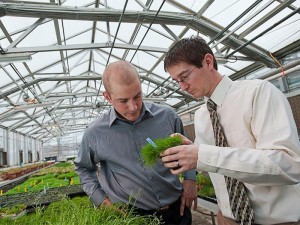Watching the Grass Grow: A Conversation with Professor of Turfgrass Science John Kaminski
July 15, 2013 in Extension, Research, Teaching
John Kaminski is an associate professor of Turfgrass Science at Penn State, who has been using social media, posts, tweets, and blogs to help propel turfgrass analysis and instruction into the future. Prior to Kaminski’s arrival at Penn State, he served as the first turfgrass pathologist at the University of Connecticut and created their Turf Diagnostic Center. Kaminski has been helping Penn State’s Turfgrass Science program produce top-notch golf course superintendents for courses around the world. This year, the program’s graduates served at Augusta National, the Merion Golf Club, and Oak Hill (where the PGA Championship will take place in August).
Given the proximity of the Oak Hill PGA Tournament next month, we thought this was an opportune moment to talk with John about his students, his interest in social media, his enthusiasm for agronomy and his propensity for bleeding blue and white. 
Tell us a bit about you and your decision to come to Penn State?
I received my bachelors degree in Turfgrass Science and Landscape Contracting from Penn State in 1998. After earning my doctorate at the University of Maryland in 2004, I was hired by the University of Connecticut to start their Turfgrass Pathology program. Although I loved New England, the opportunity to come back to Penn State and be a part of arguably the best turfgrass program in the world was an opportunity too great to pass up. It doesn’t hurt that my wife and I 1) met at Penn State; 2) got married in the Nittany Lion Inn; and 3) bleed blue and white.
Could you describe your research?
My area of research involves finding solutions to pest problems commonly found on golf course turf. My main goal in this field is to optimize cultural and chemical management strategies designed to reduce environmental impacts, while maintaining the high standard conditions required by golfers. Most of my research revolves around turfgrass diseases and select weeds commonly found on golf course. By improving our understanding of the biology of the organisms, we can more finely tune our management options to suppress them.